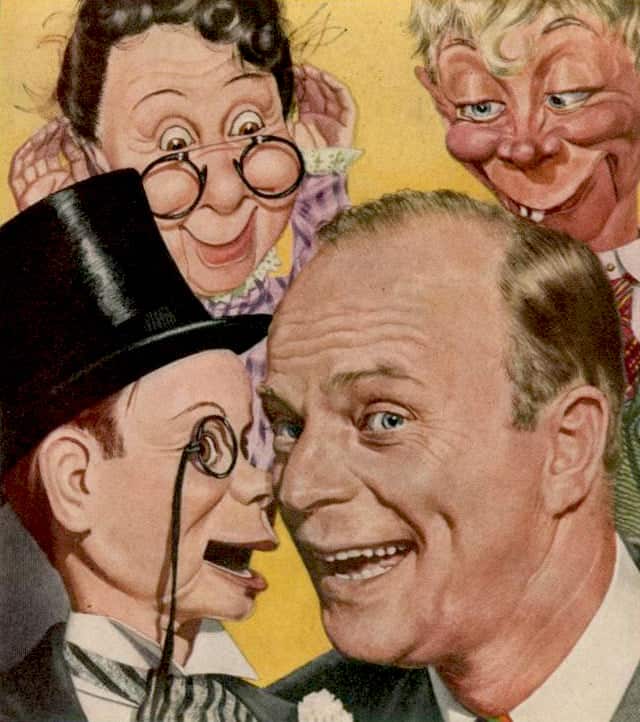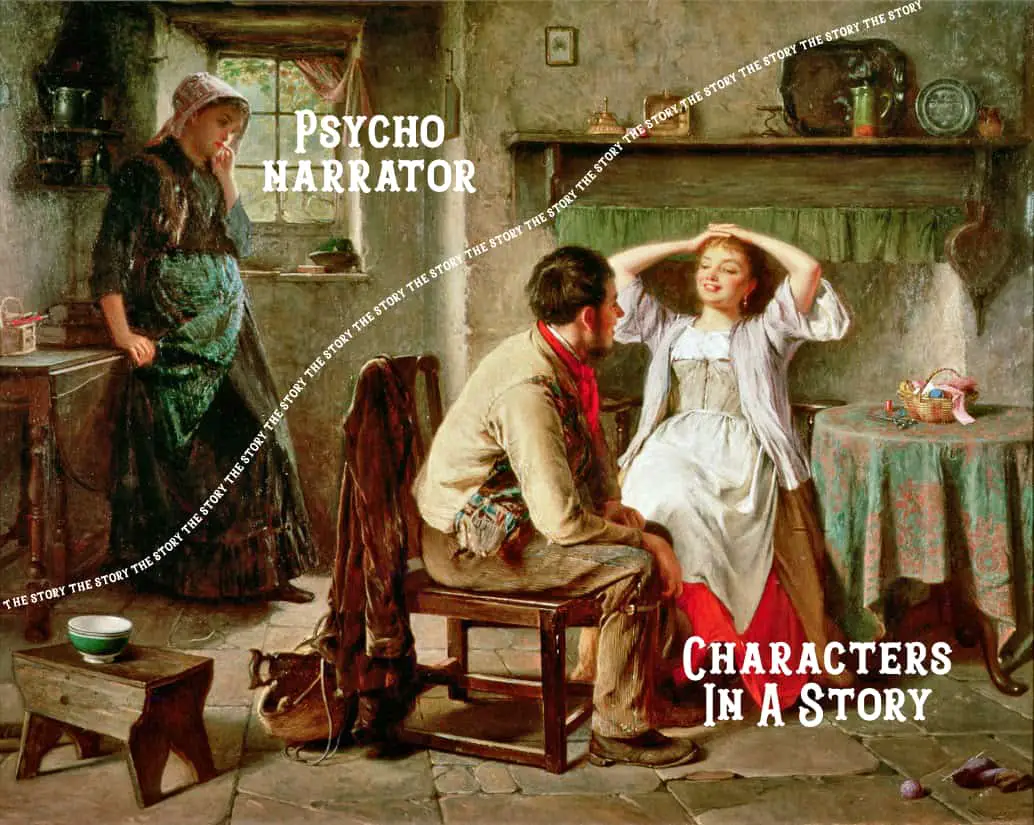Psycho-narration describes how writers make use of omniscient narrators to reflect their characters’ consciousness. Sometimes, authors use an unseen narrator, but use the language of the character they describe.
In other words, psycho narration is an ‘outside’ commentary of a character’s consciousness, but in the character’s own ‘words’. Because there’s no actual talking going on, some people say in the character’s own ‘mental language’. (This is an interesting concept in itself, because apparently some people think in words and others think in pictures, though it’s not as binary as that.)
Though subtle, in psycho narration there is no attempt to hide the narrator. We’re still dealing with an ‘overt’ narrator.
Imagine a narrator showing us a character in action by describing what they do and what they say. They then step back and talk to the audience about that character behind the character’s back.
Sometimes psycho narration goes from being ‘overt’ (not hidden) to ‘intrusive’ (in the way). Done well, psycho narration is subtle. Unless on the lookout for narrative techniques, the reader shouldn’t notice the difference between the character’s interior monologue and the narrator’s commentary.
A Brief History Of Psycho Narration
- The term was invented by Dorrit Cohn in her book Transparent Minds: Narrative Modes for Presenting Consciousness in Fiction (Princeton, New Jersey: Princeton UP, 1978). Cohn was a scholar of German and Comparative Literature.
- This mode of narration dominated fiction well into the 19th century but has been surpassed by close third person, and first person in young adult literature.
- In classic children’s literature, the psycho narration has tended to be overtly didactic. The unseen narrator impresses the ‘correct reading’ upon the audience. This is no longer accepted in contemporary fiction for children, unless it is a parody of the overt, didactic voice e.g. A Series of Unfortunate Events.
Examples of Classic Literature With Psycho Narration
- Tom Jones
- Vanity Fair
- Death In Venice
- Emma
- What Maisie Knew

Dissonant and Consonant Narration
From a technical point of view there are two essential things to solve or create when writing a novel. The first is the invention of the narrator. I think the narrator is the most important character in a novel. In some cases this importance is obvious because the narrator is also a central figure, a central character in the novel. In other cases, the narrator is not a character, not a visible figure, but an invisible person whose creation is even more complicated and difficult than the creation of one of the characters.
Mario Vargas Llosa
These are also Dorrit Cohn’s terms. She divides psycho narration into two main types.
DISSONANT: The narrator remains distanced from the consciousness they narrate. Dissonant narrators have a distinct personality. They make their opinions known.
Jane Austen’s narrators draw the narratee in, then we laugh at the characters together. These are known by writers as ‘intrusive narrators’, though that suggests it has not been well done.
Some contemporary authors have used dissonant narrators masterfully, e.g. Daniel Handler in his Unfortunate Events series. These books tend to feel like parodies of an older type of literature, even though those older works (I.e. Pride and Prejudice) weren’t taking their narrators seriously, either.
When narration is at its most dissonant you may notice the following features:
- The use of ‘distancing appellations’ like ‘poor Catherine’ or ‘our heroes’
- Use of an abstract analytical vocabulary to describe an inner world, which feels removed from the psychic experience itself (you can’t experience a strong emotion and be articulate about it at the same time)
- Speculative and explanatory commentary (maybe this will happen… this happened because…)
- Yielding to figurative thoughts and feelings even as they are being reported to the reader
CONSONANT: The narrator remains close to the consciousness they narrate. Also known as figural (figurative) narration. The narrator is effaced (basically invisible). The reader can’t easily tell the difference between the narrator’s voice and the consciousness of the character being described. We learn nothing about the consonant narrator’s position/opinions because they’re barely visible. We get no impression of them as a separate character.
Consonant narrators concentrate on showing rather than telling, like the cinema verite documentary makers who avoid showing their own faces on screen, or making use of voiceover. “I’ve shown you what’s happening — now make up your own mind.” Of course, a consonant narrator is nonetheless guiding everyone’s opinion by choosing which scenes to show and which to leave out. So a consonant narrator cannot be described as impartial.
(Other commentators use ‘overt’ and ‘covert’ to describe the same scale.)
When Might You Choose To Write With Psycho Narration?
YOU HAVE A LARGE CAST OF CHARACTERS
Maybe you have a large cast of characters because you’re writing a story about a community rather than the trials and tribulations of a single main character. Psycho narration allows the narrator to deal with a multitude of characters and situations. For this reason, psycho narration is commonly seen in social novels (aka problem novels), in which a social problem is made manifest through its effect on individuals. In these stories, the inner life of individual characters expresses general truths about human nature.
In short, psycho narration allows for ‘head-hopping’, except it’s not really head-hopping if the narrator is distant from the characters, because the narrator is never truly inside the characters’ heads.
In the old days you’d have chosen to write with a plain old omniscient point of view, and you still might. Except the modern reader is unused to reading true omniscient narration, so your work will have an old-fashioned feel. This may not be what you’re going for.
YOUR MAIN CHARACTER IS NOT A REFLECTIVE SORT
Some fictional characters simply aren’t that reflective, as people. We’re never going to learn much of value from these types, who blunder and bluster and continue on their way haphazardly. They don’t understand themselves, let alone the people around them. As main characters they can be very interesting, but as narrators? Not so much. They’ll be unreliable in a non-useful kind of way.
In this case it’s useful to have a narrator commenting ‘backstage’, or gossiping to us, the reader, behind their back, giving us the true low down.
you don’t want to poke fun at your characters
To use ten dollar words, Cohn calls this advantage ‘verbal independence from self-articulation’. Consonant psycho narration is especially useful when writing from a child’s point of view, because children have a limited view of the world, and limited ability to understand their own emotions, let alone the vocabulary to describe them. If you use consonant psycho narration, you avoid double address.
(The problem with double address is that it seems the author is condescending to their more naive subject.)
The narrator in consonant psychonarration remains effaced and readily fuses with the consciousness they narrate. Consonance does not seem to leave the narrator a voice or contribution of his/her own. The character’s thoughts and reflections are rendered without any trace of criticism or rejection. The narrator’s consciousness almost seems to coincide with the characters, making it impossible for the reader to separate the two clearly.
This means that there’s little privilege on the narrator’s part. The narrator doesn’t know much that the child protagonist doesn’t either. In children’s literature, one author well-known for doing this well is Katherine Paterson, who wrote The Bridge To Terabithia.
Mark Haddon also does consonant psychonarration very well by making use of an autistic narrator. In The Incident of the Dog in the Night-time, the reader gets an insight into what it’s like to feel (this particular kind of) autistic, because readers are not given any clues about about the outside world, and therefore cannot use neurotypical advantages to interpret the wider situation.
The narration of Forrest Gump works similarly, but because it’s a film the reader does get visual cues about how to interpret the ‘veridical’ situation of the story.
YOU DO WANT TO POKE FUN AT YOUR CHARACTERS
In this case, an external narrator describes the character’s mental state. The narrator is prominent and focuses intently on an individual psyche, remaining emphatically distanced from the consciousness he/she is narrating. In this case, the narration moves back from a character’s perspective to allow for a sharper degree of commentary and analysis. From this position of distance, the narrator also functions as the vocaliser in relation to a character who appears only as a focalised.
Pride and Prejudice: “If Elizabeth, when Mr Darcy gave her the letter, did not expect it to contain a renewal of his offers, she had formed no expectation at all of its contents.”
Basically, this is the narrator winking at the reader. Double address has its political pitfalls — see this post on satire.
YOUR PLOT JUMPS AROUND IN TIME
Psycho narrators have almost unlimited temporal flexibility. The psycho narrator can jump around in time.
Header painting: Haynes King – Jealousy and Flirtation 1874

